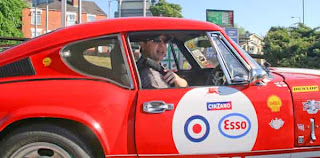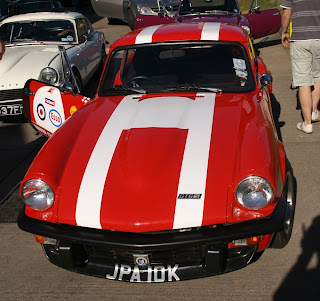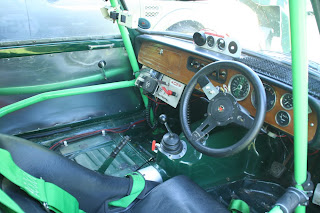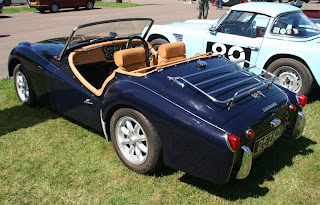The Last Adventure
If restoring a ship like the SS Great Britain is too large a task, how about building a steam engine from scratch?
My favourite Top Gear episode is the "1949" race from London and Edinburgh between an XK120 Jaguar, Vincent Black Shadow motorcycle and a steam engine. Later, I was amazed to learn that the steam engine Jeremy Clarkson rode in was only a year old. A one year old steam engine, not lovingly restored from rusting iron but built from original blueprints! Her name is Tornado.


When I was planning my expedition to the UK, I found that Tornado was running from Liverpool St Station to Norwich and back a couple of days before I was due to fly home. The trip had already involved planes, trains, Triumphs, boats, so why not a steam train as well?
Our departure from Liverpool St could best be described as controlled chaos, with passengers vying for platform room with spectators. Once in the right carriages and settled, we watched as billows of steam and smoke wafted up, becoming trapped under the vaulted, Victorian roof of the station. No one seemed to mind though, apart from the pigeons. And then, after relayed whistles and the slamming of carriage doors, Tornado woke up. She let out a series of shrieks, shuddered and began to move. We all had our heads out the windows to watch the platform and bystanders slide past, and listened to the chuffs, hisses and mechanical snufflings as she pulled away and slowly gathered pace.
And so, on a bright Spring morning in late May, we set out across Essex and Norfolk. All along the route - about 280 miles! - people were standing at stations, level crossings, overbridges, in back yards and on ladders. Thousands of people, drawn by the magic of steam, waving and taking photos from the most obscure spots. Onboard, the ride was beautifully smooth, and she sat at about 70mph for longs stretches. Apart from the steam whistle, a quiet chuffing was the only reminder that we were being pulled by a machine fired by coal and not electricity. Errr, until I stuck my head out the window and got a face full of soot while trying to photograph the big green monster!



We were greeted at Norwich train station by crowds wanting to see Tornado on her first trip to the city. After slipping past the police and barricades, we wandered off into the town centre for a late lunch. I found a delightful if worryingly named pub called "The Murderer's Arms", and set about testing the local ales. They passed. After a wander around town and a ten-minute tour of Norwich Castle, it was back to the train for the return journey.

Even as the sun set over green fields, the train was waved on by clusters of onlookers. Eventually the sun set, and we pulled into Liverpool St around nine o'clock.



Background:
The Peppercorn locos were named after their designer, Arthur Peppercorn. Forty nine were built in 1948-49, but the age of diesel rendered them redundant, and the last, 60145 'Saint Mungo', was melted down in 1966. However, the blueprints were saved, and the project to recreate a missing link in the history of British steam started in 1990. 60163 Tornado, named after the RAF jets, was completed in 2008.
The A1 Locomotive trust is at www.a1steam.com
My favourite Top Gear episode is the "1949" race from London and Edinburgh between an XK120 Jaguar, Vincent Black Shadow motorcycle and a steam engine. Later, I was amazed to learn that the steam engine Jeremy Clarkson rode in was only a year old. A one year old steam engine, not lovingly restored from rusting iron but built from original blueprints! Her name is Tornado.


When I was planning my expedition to the UK, I found that Tornado was running from Liverpool St Station to Norwich and back a couple of days before I was due to fly home. The trip had already involved planes, trains, Triumphs, boats, so why not a steam train as well?
Our departure from Liverpool St could best be described as controlled chaos, with passengers vying for platform room with spectators. Once in the right carriages and settled, we watched as billows of steam and smoke wafted up, becoming trapped under the vaulted, Victorian roof of the station. No one seemed to mind though, apart from the pigeons. And then, after relayed whistles and the slamming of carriage doors, Tornado woke up. She let out a series of shrieks, shuddered and began to move. We all had our heads out the windows to watch the platform and bystanders slide past, and listened to the chuffs, hisses and mechanical snufflings as she pulled away and slowly gathered pace.
And so, on a bright Spring morning in late May, we set out across Essex and Norfolk. All along the route - about 280 miles! - people were standing at stations, level crossings, overbridges, in back yards and on ladders. Thousands of people, drawn by the magic of steam, waving and taking photos from the most obscure spots. Onboard, the ride was beautifully smooth, and she sat at about 70mph for longs stretches. Apart from the steam whistle, a quiet chuffing was the only reminder that we were being pulled by a machine fired by coal and not electricity. Errr, until I stuck my head out the window and got a face full of soot while trying to photograph the big green monster!



We were greeted at Norwich train station by crowds wanting to see Tornado on her first trip to the city. After slipping past the police and barricades, we wandered off into the town centre for a late lunch. I found a delightful if worryingly named pub called "The Murderer's Arms", and set about testing the local ales. They passed. After a wander around town and a ten-minute tour of Norwich Castle, it was back to the train for the return journey.

Even as the sun set over green fields, the train was waved on by clusters of onlookers. Eventually the sun set, and we pulled into Liverpool St around nine o'clock.

Sunset on the way back to London

The engine crew after a day in the cab

Liverpool Station, resting.
Background:
The Peppercorn locos were named after their designer, Arthur Peppercorn. Forty nine were built in 1948-49, but the age of diesel rendered them redundant, and the last, 60145 'Saint Mungo', was melted down in 1966. However, the blueprints were saved, and the project to recreate a missing link in the history of British steam started in 1990. 60163 Tornado, named after the RAF jets, was completed in 2008.
The A1 Locomotive trust is at www.a1steam.com












































